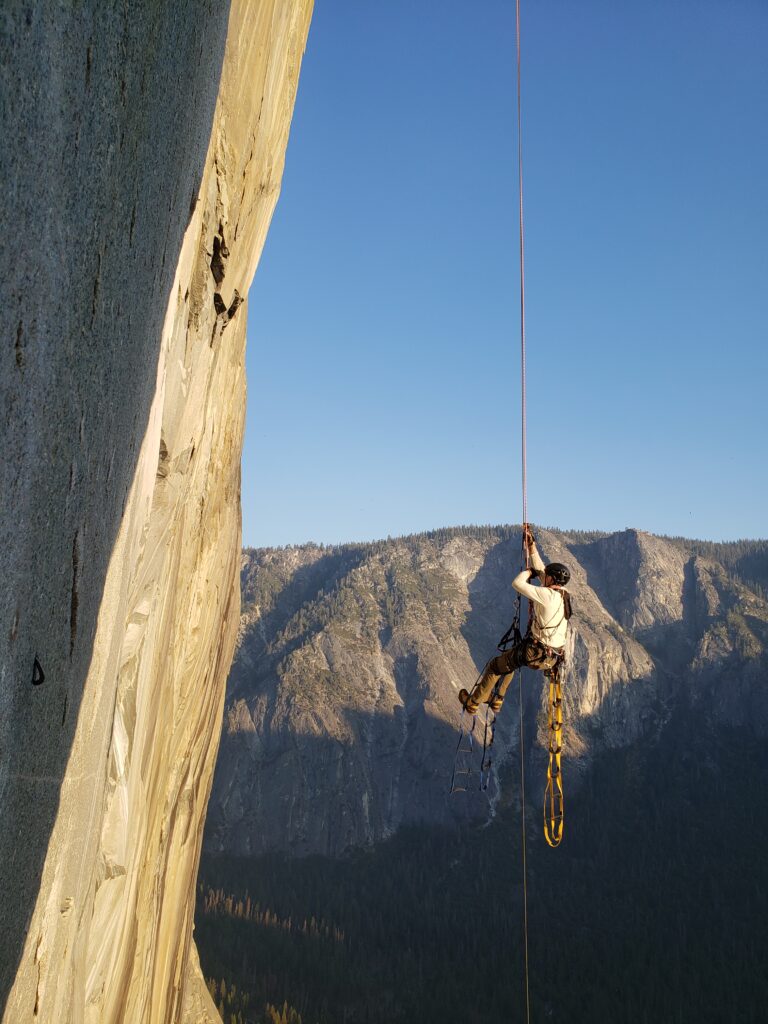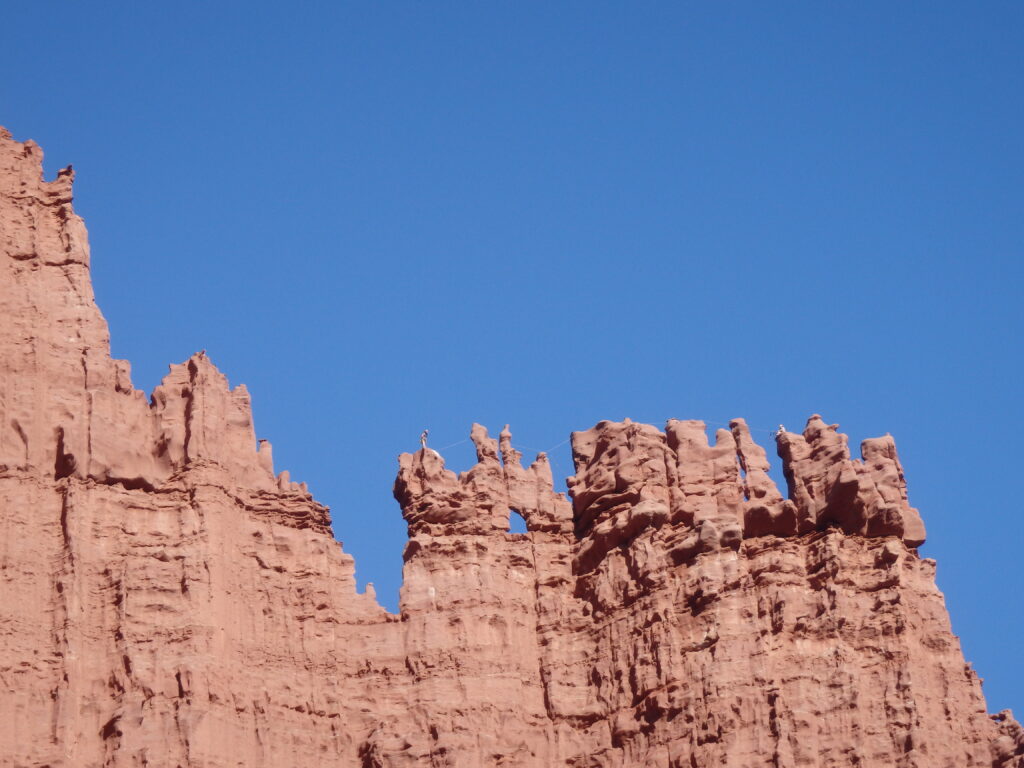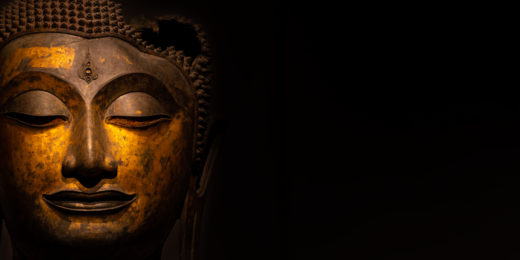These are stories of Stanford Medicine faculty, researchers and physicians whose journeys into medicine didn't take the traditional path.
It was before dawn when Joseph Forrester came to on the icy side of a mountain. In the darkness, he thought he was on Long's Peak in the Rockies, a familiar climb for the 20-year-old Colorado College junior. But something was very wrong.
"It took me a while to even remember where I was," he said. In fact, he was on the south face of Aconcagua in Argentina, the tallest peak in South America, about 2,000 feet up the 22,000-foot ascent. He and his climbing buddy, Joel, had chopped a ledge into the icy mountainside to sleep on for the night. Now Joel was looking at him with concern.
During the night, rocks had fallen on Forrester, cracked his skull, broken his lower back and knocked him unconscious. He was bleeding profusely into his sleeping bag from a hole in his spine. Joel shoved a bunch of socks into his back to try to stop the bleeding. They had no way to call for help, so as soon as the sun rose, Joel made the dangerous descent by himself, climbing the 2,000 feet down and hiking across a glacier to find park rangers.
Forrester waited on the frozen ledge, barely able to stand. "I thought there was a non-zero chance I was going to die," he said. A day and a half later, help arrived by helicopter.

After a week in an Argentinian hospital, a ripped suture on the plane back to the United States, and several weeks recovering from a bad bacterial infection, Forrester began to reconsider his original career goal: to be a professional climber. "That was the point where I said, 'You know, maybe climbing isn't going to be a long-term career strategy. I may need to diversify a little bit,'" said Forrester, who is now a trauma surgeon at Stanford Medicine.
Eighteen years later, Forrester applies the same tenacity, spirit of exploration and nerves of steel that carried him up mountains to repairing broken ribs and other traumatic injuries in the operating room.
Learning to climb
Forrester grew up around mountains in Colorado and was an adventure seeker from a young age. The wilderness that intimidates some was a draw for Forrester. The more inaccessible the location, the more he wanted to find a way there. An uncle who worked for Outward Bound, an outdoor education program, introduced him to climbing.
"Now so many kids climb, and there are climbing gyms; it's such a common thing," he said. "But when I was growing up, that really wasn't the case."
From the start, he and his friends learned how to climb safely outdoors and how to manage natural hazards like lightning storms, avalanches and breaking rocks. They found climbing mentors and pored over climbing books like Basic Rock Craft and Freedom of the Hills. Mostly they learned by trial and error.
"I think early on it was that draw of exploration and being independent -- and spending the weekend away from parents," he said.
He chose Colorado College to follow in the footsteps of many legendary climbers, and he majored in biochemistry to appease his parents.
In college, Forrester expanded his climbing into the Utah desert, up to Alaska, down to Mexico and, in January 2005, to Argentina. He'd been sure he could devote his life to climbing, whether that meant working as a climbing guide or getting by with odd jobs.
Medical school
After the accident on Aconcagua, Forrester applied to medical school, inspired by the doctors who had performed an emergency surgery to save his life. He was accepted to only one school -- the University of Virginia. "It turned out to be one of the best things that ever happened to me," he said. But at the time, he wasn't so sure.
"When I first went to medical school, I had a lot of self-doubt as to whether it was really the path I wanted to take," he said. "By the end of my second year, I was really internally struggling with what I wanted to do."
He decided to take a gap year between his third and fourth years to travel and climb. He'd gotten a grant from the American Alpine Club to make a first ascent - that is, to be the first to climb and document a new route - on Mount Mulanje in Malawi. He liked long-distance river trips, too, and planned to paddle the Missouri and Mississippi Rivers from start to finish.

When he informed the medical student dean, he was told that his adventuring plans were all well and good - but he also needed to do something academic.
"I'd always been somewhat interested in infectious disease," Forrester said. "I'd read The Hot Zone and all the Ebola books." He figured if he enrolled in a master's program he could do remotely, he could fit it in between his travels.
That year - which included a three-and-a-half-month solo kayak trip, a month climbing in Malawi, some skiing here and there, and his first year of a master's program in infectious disease from the London School of Hygiene and Tropical Medicine - was a turning point.
"As I took time away from medicine, I realized it's actually something that I was starting to enjoy quite a bit," he said.
During his fourth year of medical school, he did a rotation with the trauma service, which affirmed his interest in surgery. "I was pretty hooked at that point," he said. He was matched to a general surgery residency at Stanford Medicine.
A stint with the Centers for Disease Control
After his second year of surgical residency - the hardest year, full of long nights - uncertainty crept back in. "Again, I was stuck in this existential crisis of whether this was what I really want to do with my life," he said. "I thought I wanted to do surgery, but I was having all these doubts."
He proposed to Marc Melcher, MD, PhD, the program director of the surgical residency, that he take some time away from medicine to paddle the Yukon and Amazon rivers from source to sea. Again his adventuring plans had to be reined in. Melcher encouraged him to choose something more related to his profession. He applied to the Epidemic Intelligence Service, a training program in field epidemiology run by the Centers for Disease Control and Prevention. Initially developed in the 1950s to respond to biological weapon threats, the service had evolved into a training program for disease detectives who investigate public health threats around the world.
Forrester was accepted into the bacterial vector-borne pathogen branch in Fort Collins, Colorado, where he studied Lyme disease, plague and tularemia. In 2014, driving south on I-25 to Denver, he got a call about the increase in Ebola cases in West Africa. Would he be interested in going as a field agent? He said yes immediately. "I was like, this is what I've been training for my entire life," he recalled.
Not everyone was as keen to run toward a deadly epidemic. Three days later, the service sent out another request for field agents. They had 10 open positions and only one person had signed up. Forrester flew to Liberia that summer. The country's health care infrastructure had shut down, most aid organizations had left and the mortality rate from Ebola was 70% to 80%. The agents were told not to expect an air evacuation if they were infected.
"It was part terror, part excitement," he said.
In Liberia, he retraced the steps of Ken Brantley and Nancy Writebol, two health care workers who were the first Americans to be infected with Ebola, trying to piece together how they had been exposed. He convinced the U.S. Embassy to lend him a Land Rover and a driver so they could track down cases in more remote parts of the country. He didn't always wear the personal protective equipment they'd been provided because "if you're the one person wearing PPE in a room, it's really hard to get information from people," he said.
His time in Africa provided him with a new perspective. "It gave me an appreciation for our mortality, how important it is to enjoy each day as much as we can - because you never know what might happen."
The pandemic
Four years later, when another virus gripped the entire world, Forrester was more prepared than most.
By then, he had returned from Africa to Stanford Medicine and finished his surgical training. Though he'd loved his time with the Epidemic Intelligence Service, he missed using his hands to fix tangible problems. "That itch wasn't getting scratched," he said.
In the first year and a half of the pandemic, he performed the majority of tracheostomies on COVID-19 patients, a procedure with a high risk of virus exposure. Again he was volunteering to put himself in harm's way. "I think when that rock knocked my head, it knocked a few neurons off," he joked. "I have a hard time saying no."
"I hope, by the time I head to wherever it is after this life, that I feel like I was someone who would run toward a challenge," he added.
Closer to home
Today, Forrester is an assistant professor of surgery who patches up people after life-threatening injuries. The lessons he's learned from decades of climbing - when to be more cautious and where to push the boundaries - also inform his surgical work.
"If you're uncomfortable taking risks, then you miss out on so many incredible opportunities, whether that's in life, in climbing or in surgery to save someone's life," he said.
He is the medical director of the Stanford Chest Wall Injury Center, where he is pioneering better ways to treat serious rib fractures, which can be excruciatingly painful. Traditionally, people with broken ribs had to undergo major surgery or, more often, were simply given pain medications and told to tough it out, he said. "But anatomically and physiologically, it never made sense."
He consulted experts across the country to innovate less invasive ways to surgically stabilize rib fractures, which allow faster and less painful recovery. He's also conducting clinical trials for cryoneurolysis - freezing neurons - to give patients pain control that lasts for three to six months.
On the side, he publishes research on climbing injuries - including a recent case report of his own torn shoulder - and wildlife encounters gone wrong.
He is no less passionate about climbing, though his goals have shifted more locally in recent years. "It doesn't have to be as much of an across-the-world, high-stakes adventure," he said.
These days, he's more often bouldering with his family: his wife - Hilary Bagshaw, MD, also a climber and a radiation oncologist at Stanford Medicine - and two young children.
"Rather than go to the movies, we go climbing," he said.
Go here for more stories from our Unconventional Paths series.
Photo courtesy of Joe Forrester






